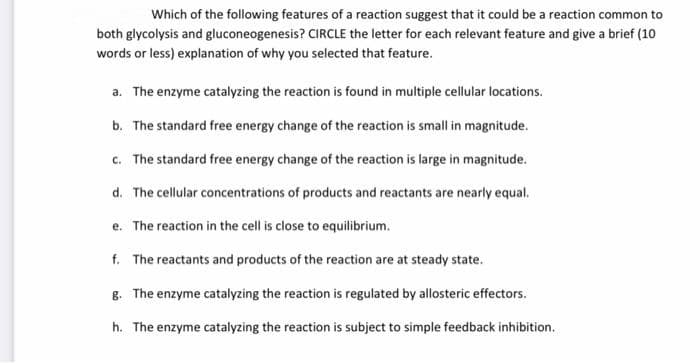Which of the following features of a reaction suggest that it could be a reaction common to both glycolysis and gluconeogenesis? CIRCLE the letter for each relevant feature and give a brief (10 words or less) explanation of why you selected that feature.
Which of the following features of a reaction suggest that it could be a reaction common to both glycolysis and gluconeogenesis? CIRCLE the letter for each relevant feature and give a brief (10 words or less) explanation of why you selected that feature.
Biochemistry
6th Edition
ISBN:9781305577206
Author:Reginald H. Garrett, Charles M. Grisham
Publisher:Reginald H. Garrett, Charles M. Grisham
Chapter20: Electron Transport And Oxidative Phosphorylation
Section: Chapter Questions
Problem 19P
Related questions
Question
Need help.

Transcribed Image Text:Which of the following features of a reaction suggest that it could be a reaction common to
both glycolysis and gluconeogenesis? CIRCLE the letter for each relevant feature and give a brief (10
words or less) explanation of why you selected that feature.
a. The enzyme catalyzing the reaction is found in multiple cellular locations.
b. The standard free energy change of the reaction is small in magnitude.
c. The standard free energy change of the reaction is large in magnitude.
d. The cellular concentrations of products and reactants are nearly equal.
e. The reaction in the cell is close to equilibrium.
f. The reactants and products of the reaction are at steady state.
8. The enzyme catalyzing the reaction is regulated by allosteric effectors.
h. The enzyme catalyzing the reaction is subject to simple feedback inhibition.
Expert Solution
This question has been solved!
Explore an expertly crafted, step-by-step solution for a thorough understanding of key concepts.
Step by step
Solved in 3 steps

Knowledge Booster
Learn more about
Need a deep-dive on the concept behind this application? Look no further. Learn more about this topic, biology and related others by exploring similar questions and additional content below.Recommended textbooks for you

Biochemistry
Biochemistry
ISBN:
9781305577206
Author:
Reginald H. Garrett, Charles M. Grisham
Publisher:
Cengage Learning

Biochemistry
Biochemistry
ISBN:
9781305577206
Author:
Reginald H. Garrett, Charles M. Grisham
Publisher:
Cengage Learning